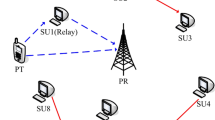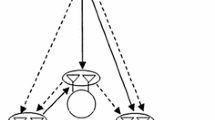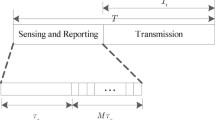Abstract
Cognitive radio solves the problem of scarcity of radio spectrum to a great extent in that it allows unlicensed users to coexist with licensed users. It allows effective utilization of radio spectrum by offering radio cells the ability of radio sensing and dynamic spectrum sharing. The throughput of spectrum sharing cognitive radio can be maximized by performing data transmission and spectrum sensing at the same time. Cooperative communications and networking allow distributed terminals in a wireless network. The main problem with cognitive radio is to sense the presence of primary users over a wide range of spectrum. Cooperative spectrum sensing is used here to detect those users more reliably. It is investigated whether cooperative communication for spectrum in cognitive radio enhances the efficiency of spectrum sharing. The maximum power that can be adapted by the secondary user without causing significant interference to a primary user is investigated. An algorithm is proposed for the same. Closed-form expression for ergodic throughput is derived for the systems and is compared with the conventional cognitive radio system. An expression for the outage capacity of the system is also derived for average transmit and interference power constraints under truncated channel information with fixed rate technique.















Similar content being viewed by others
References
MacKenzie AB, Reed JH (2009) Cognitive radio and networking research at Virginia Tech. Proceedings of the IEEE 97(4):660–668
Mitola J, Maguire GQ Jr (1999) Cognitive radios: making software radio more personal. IEEE Personal Communications 6(4):13–18
Zhongyu H, Tao S (2008) “Adaptive CRN spectrum sensing scheme with excellence in topology and scan scheduling,”. International Conference on Sensing Technology, Tainan, Taiwan, pp 384–391
Dixit S, Periyalwar S, Yanikomeroglu H (2009) A distributed framework with a novel pricing model for enabling dynamic spectrum access for secondary users. IEEE Vehicular Technology Conference, Anchorage, AK, USA
S. Geirhofer, L. Tong, and B. Sadler, “Dynamic Spectrum access in the time domain: modeling and exploiting white space”, IEEE Communications Magazine, vol. 45, no. 5, pp. 66, May 2007.
Krishna R, Cumanan K, Xiong Z, Lambotharan S (2010) A novel cooperative relaying strategy for wireless networks with signal quantization. IEEE Transactions on Vehicular Technology 89(1):485–489
Zhao Q, Swami A (2007) A decision-theoretic framework for opportunistic spectrum access. IEEE Transactions on Wireless Communications 14(4):14–20
Ghasemi A, Sousa ES (2007) Fundamental limits of spectrum sharing in fading environments. IEEE Transactions on Wireless Communications 6(2):649–658
Gastpar M (2007) On capacity under receive and spatial spectrum-sharing constraints. IEEE Transactions on Information Theory 53(2):471–487
Musavian L, Aïssa S (2007) Ergodic and outage capacities of spectrum sharing systems in fading channels. Proceedings of IEEE GLOBECOM, Washington DC, USA, pp 3327–3331
Haykin S (2005) Cognitive radio: brain-empowered wireless communications. IEEE Journal on Selected areas in Communications 23(2):201–220
Stotas S, Nallanathan A (2011) Enhancing the capacity of spectrum sharing cognitive radio networks. IEEE Transactions on Vehicular Technology 60(8):3768–3779
Di H, Li W, Fusheng Z, Weiyao L (2012) An enhanced covariance spectrum sensing technique based on stochastic resonance in cognitive radio networks. IEEE International Symposium on Circuits and Systems, South Korea, Seoul, pp 818–821
John G. Proakis, and M. Salehi, Digital Communications, 5th edition, McGraw-Hill, pp. 366, 2008.
Shiung D, Chen KC (2009) On the optimal power allocation of a cognitive radio network. IEEE International Symposium on Personal, Indoor and Mobile Radio Communications, Tokyo, Japan, pp 1241–1245
Lim TJ, Zhang R, Liang YC, Zeng Y (2008) GLRT-based spectrum sensing for cognitive radio. IEEE Global Telecommunications Conference, New Orleans, LA, USA
Dev K, Tewari R, Dixit M, Dutta J (2007) Finding trade-off solutions close to KKT points using evolutionary multi-objective optimization. IEEE Conference on Evolutionary Computations, Singapore
Alghamdi OA, Ahmed MZ, Abu-Rgheff MA (2010) Probabilities of detection and false alarm in multitaper based spectrum sensing for cognitive radio systems in AWGN. IEEE International Conference on Communication Systems (ICCS), Singapore, pp 579–584
Gang C, Hong-Lai L (2009) Optimal power allocation for decode and forward cooperative communication with multiple relays. IEEE Conference on Wireless Communications Networking and Mobile Computing, Las Vegas, USA
Bhaskar V (2013) Novel closed-form expressions for ergodic capacity of rate-adaptive MIMO OSFBC-OFDM systems over various adaptation policies. Wireless Personal Communications. doi:10.1007/s11277-013-1537-6
Subhashini J, Bhaskar V (2013) Capacity analysis of Rayleigh fading channels in low SNR regime for maximal ratio combining diversity due to combining errors. IET Communications 7(8):745–754
Krishna SR, Bhaskar V (2012) Spectrum efficiency for rate-adaptive MIMO OSFBC-OFDM systems over various adaptation policies. International Journal of Soft Computing and Engineering (IJSE) 2(3):81–85
Verghese R, Thai Subha S, Bhaskar V (2012) Ergodic capacity analysis and asymptotic tightness for multi-element antenna array with spatial correlation and transmit water-filling. IET Communications 6(1):22–28
Goldsmith AJ, Varaiya PP (1997) Capacity of fading channels with channel-side information. IEEE Transactions on Information Theory 43(6):1986–1992
Shyamala S, Bhaskar V (2011) Capacity of multiuser multiple input multiple output orthogonal frequency division multiplexing systems with doubly correlated channels for various fading distributions. IET Communications 5(9):1230–1236
Bhaskar V (2009) Capacity evaluation for equal gain diversity schemes over Rayleigh fading channels. International Journal of Electronics and Communications (AeUe) 63(4):235–240
Bhaskar V (2007) Spectrum efficiency evaluation for MRC diversity schemes under different adaptation policies over generalized Rayleigh fading channels. International Journal on Wireless Information Networks 14(3):191–203
Bhaskar V (2007) Spectrum efficiency evaluation for MRC diversity schemes over generalized Rician fading channels. International Journal on Wireless Information Networks 14(3):209–223
Ejaz W, Ul Hasan N, Kim HS, Azam MA (2011) Fully distributed cooperative spectrum sensing for cognitive radio ad hoc networks. IEEE Frontiers of Information Technology 37(4):9–13
Kang X, Liang YC, Garg HK, Zhang L (2009) Sensing-based spectrum sharing in cognitive radio networks. IEEE Transactions on Vehicular Technology 58(8):4649–4654
Lundén J, Koivunen V, Huttunen A, Poor HV (2007) Spectrum sensing in cognitive radios based on multiple cyclic frequencies. International Conference on Crown Castle Communications, Orlando, FL, pp 37–43
Zeng Y, Liang YC (2009) Spectrum-sensing algorithms for cognitive radio based on statistical covariances. IEEE Transactions on Vehicular Technology 58(4):1804–1815
Zhang R (2009) On peak versus average interference power constraints for protecting primary users in cognitive radio networks. IEEE Transactions on Wireless Communications 8(4):2112–2120
Ben-Tal A, Nemirovski A (2001) Lectures on modern convex optimization: analysis, algorithms, and engineering applications, Philadelphia, PA, USA. http://www.utdallas.edu/~torlak/courses/ee6391/lectures/lecture5.pdf. Accessed 01 Aug 2001
Palomar DP, Chiang M (2006) A tutorial on decomposition methods for network utility maximization. IEEE Journals on Selected areas in Communications 24(8):1439–1451
Federal Communications Commission (2002) Spectrum Policy Task Force report. Federal Communications Commission, Washington DC, pp. 02–155
Author information
Authors and Affiliations
Corresponding author
Rights and permissions
About this article
Cite this article
Bhaskar, V., Dutta, B. Ergodic and outage capacity maximization of cognitive radio networks in cooperative relay environment using optimal power allocation. Ann. Telecommun. 69, 621–632 (2014). https://doi.org/10.1007/s12243-013-0419-y
Received:
Accepted:
Published:
Issue Date:
DOI: https://doi.org/10.1007/s12243-013-0419-y




